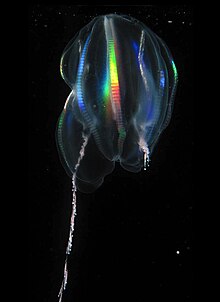Cydippida
| Cydippida | |
|---|---|
 | |
| Mertensia ovum | |
| Scientific classification | |
| Domain: | Eukaryota |
| Kingdom: | Animalia |
| Phylum: | Ctenophora |
| Class: | Tentaculata |
| Order: | Cydippida |
| Families | |
| See text | |
Cydippida is an order of comb jellies. They are distinguished from other comb jellies by their spherical or oval bodies, and the fact their tentacles are branched, and can be retracted into pouches on either side of the pharynx. The order is not monophyletic, that is, more than one common ancestor is believed to exist.[1]
Anatomy
[edit]Cydippids have bodies that are more or less rounded, sometimes nearly spherical and other times more cylindrical or egg-shaped; the common coastal "sea gooseberry," Pleurobrachia, has an egg-shaped body with the mouth at the narrow end.[2] From opposite sides of the body extends a pair of long, slender tentacles, each housed in a sheath into which it can be withdrawn.[3] Some species of cydippids have bodies that are flattened to various extents, so that they are wider in the plane of the tentacles.[2]
The tentacles are typically fringed with tentilla ("little tentacles"), although a few genera have simple tentacles without these side-branches. The tentacles and tentilla are densely covered with microscopic colloblasts that capture prey by sticking to it. These are specialized mushroom-shaped cells in the outer layer of the epidermis, and have three main components: a domed head with vesicles (chambers) that contain adhesive; a stalk that anchors the cell in the lower layer of the epidermis or in the mesoglea; and a spiral thread that coils round the stalk and is attached to the head and to the root of the stalk. The function of the spiral thread is uncertain, but it may absorb stress when prey tries to escape, and thus prevent the colloblast from being torn apart.[2]
In addition to colloblasts, members of the genus Haeckelia, which feed mainly on jellyfish, incorporate their victims' stinging cnidocytes into their own tentacles — some cnidaria-eating nudibranchs similarly incorporate cnidocytes into their bodies for defense.[4] The tentilla of Euplokamis differ significantly from those of other cydippids: they contain striated muscle, a cell type otherwise unknown in the comb jellies; and they are coiled when relaxed, while the tentilla of all other known ctenophores elongate when relaxed.
Euplokamis' tentilla have three types of movement that are used in capturing prey: they may flick out very quickly (in 40 to 60 milliseconds); they can wriggle, which may lure prey by behaving like small planktonic worms; and they coil around prey. The unique flicking is an uncoiling movement powered by contraction of the striated muscle. The wriggling motion is produced by smooth muscles, but of a highly specialized type. Coiling around prey is accomplished largely by the return of the tentilla to their inactive state, but the coils may be tightened by smooth muscle.[5]
There are eight rows of combs that run from near the mouth to the opposite end, and are spaced evenly round the body.[3] The "combs" beat in a metachronal rhythm rather like that of a Mexican wave.[6] From each balancer in the statocyst a ciliary groove runs out under the dome and then splits to connect with two adjacent comb rows, and in some species runs all the way along the comb rows. This forms a mechanical system for transmitting the beat rhythm from the combs to the balancers, via water disturbances created by the cilia.[2]
Families
[edit]Cydippida contains 12 families:[7]
- Aulacoctenidae
- Bathyctenidae
- Cryptocodidae
- Ctenellidae
- Dryodoridae
- Euplokamididae
- Haeckeliidae
- Lampeidae
- Mertensiidae
- Pleurobrachiidae
- Pukiidae
- Supaiidae contains Supa (genus)
There are additionally incertae sedis genera including Duobrachium.[1]
See also
[edit]- Benthic comb jelly – Comb jelly found in the Ryukyu Trench near Japan
References
[edit]- ^ a b Ford, Michael; Bezio, Nicholas; Collins, Allen (18 November 2020). "Duobrachium sparksae (incertae sedis Ctenophora Tentaculata Cydippida): A new genus and species of benthopelagic ctenophore seen at 3,910 m depth off the coast of Puerto Rico". Plankton and Benthos Research. 15 (4): 296–305. doi:10.3800/pbr.15.296.
- ^ a b c d Ruppert, E. E.; Fox, R. S. & Barnes, R. D. (2004). Invertebrate Zoology (7th ed.). Brooks / Cole. pp. 111–124. ISBN 0-03-025982-7.
- ^ a b Hinde, R. T. (1998). "The Cnidaria and Ctenophora". In Anderson, D. T. (ed.). Invertebrate Zoology. Oxford University Press. pp. 28–57. ISBN 0-19-551368-1.
- ^ Mills, C. E.; R. L. Miller (February 1984). "Ingestion of a medusa (Aegina citrea) by the nematocyst-containing ctenophore (Haeckelia rubra, formerly Euchlora rubra): phylogenetic implications". Marine Biology. 78 (2): 215–221. doi:10.1007/BF00394704. S2CID 17714037.
- ^ Mackie, G. O.; Mills, C. E.; Singla, C. L. (March 1988). "Structure and function of the prehensile tentilla of Euplokamis (Ctenophora, Cydippida)". Zoomorphology. 107 (6). Berlin / Heidelberg: Springer: 319–337. doi:10.1007/BF00312216. S2CID 317017.
- ^ Craig, C. L.; Okubo, A. (April 1990). "Physical constraints on the evolution of ctenophore size and shape". Evolutionary Ecology. 4 (2): 115–129. doi:10.1007/BF02270909. S2CID 24584197.
- ^ Mills, C. E. "Cydippida". WoRMS. World Register of Marine Species.
{{cite web}}: Missing or empty|url=(help)


 French
French Deutsch
Deutsch